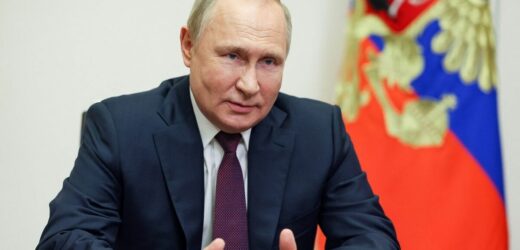
We use your sign-up to provide content in ways you’ve consented to and to improve our understanding of you. This may include adverts from us and 3rd parties based on our understanding. You can unsubscribe at any time. More info
Despite Russia previously warning that to do so would be a ‘provocative escalation’, Mr Biden confirmed that the US would now be despatching high tech weapons systems to Kyiv to help you be invaded country ‘defend itself’. But just hours after the announcement, Moscow accused Mr Biden of ‘deliberately adding fuel to the fire’ and said Russian forces would now be carrying out nuclear drills in a clear warning to both the US and the West.
The American announcement, described by commentators as a ‘significant measure’, came within the latest US aid package.
President Biden said the more advanced medium-range High Mobility Advanced Rocket System (HIMARS) would help Ukraine defend itself.
The US had previously held out on sending such advanced heavy duty military equipment, despite repeated requests from authorities in Kyiv.
But announcing the move in an interview with the New York Times, Mr Biden said the lethal rocket system would strengthen Kyiv’s negotiating position against Russia and make a diplomatic solution more likely.
He said: “That is why I’ve decided that we will provide the Ukrainians with more advanced rocket systems and munitions that will enable them to more precisely strike key targets on the battlefield in Ukraine.”
But he stressed: “We are not going to send to Ukraine rocket systems that can strike into Russia.”
However, the announcement sparked fury in the Kremlin which had warned any such move would be a provocative escalation.
And shortly after Mr Biden’s interview was published, Russian military officials announced that the country’s nuclear forces were holding drills in Ivanovo province near Moscow.
Previously Russian Foreign Minister Sergei Lavrov has accused the West of “pumping up the Ukrainian nationalists with weapons” and said that any cargo of arms bound for Ukraine would become a legitimate target for Moscow.
The ministry has said that Nato countries are “playing with fire” by sending weapons to Ukraine.
And Russia also said it had now completed testing of its hypersonic Zircon cruise missile, a senior military official told the Russian news agency TASS.
This came after Russia’s defence ministry said last week it had successfully test-fired the cruise missile from a vessel in the BarentsSea to a target some 1,000 km (625 miles) away in the White Sea.
But the new weaponry now being sent from the US to bolster Ukrainian forces will include the M142 High Mobility Artillery Rocket System (HIMARS).
The systems can launch multiple precision-guided missiles at targets as far as 70km (45 miles) away – far further than the artillery that Ukraine currently has.
They are also believed to be more accurate than Russian equivalents being used by Putin’s own forces.
A senior White House official later confirmed the move but did not specify how many of them would be supplied.
But the US expects Ukraine to deploy the weapons in the eastern Donbas region, where the fighting is most intense, and where they can be used to strike Russian artillery units and forces targeting Ukrainian towns.
Ukrainian forces, led by President Volodymyr Zelensky, had repeatedly appealed to the West to provide them with such high tech weaponry.
Just last month, Ukraine’s army chief said that getting the HIMARS units would be “crucial” in allowing it to counter Russian missile attacks.
The latest rockets will be the centrepiece of a $700million (£556million) support package for Ukraine that was formally unveiled by White House officials.
Helicopters, anti-tank weapons, tactical vehicles and spare parts are to be included in what will be the 11th package of military aid approved by the US for Ukraine since the invasion began in February.
Mr Biden said that the US’s goal was simply to see a “democratic, independent, sovereign” Ukraine, not to oust Mr Putin from his role as Russian president or to seek broader conflict with Moscow.
But he blamed Russia’s continued aggression for the stalling of peace efforts, adding that the US would never put pressure on Ukraine to concede any of its territory in return for an end to the conflict.
Directly addressing the risk of nuclear weapons being used in Ukraine, Mr Biden said “we currently see no indication” of this being Russia’s intention – but warned that doing so would be unacceptable and bring with it “severe consequences”.
On the ground in Ukraine, President Volodymyr Zelensky accused Moscow of ‘madness’ after Russian missile strikes targeted a chemical plant in the eastern city of Severodonetsk.
Residents still living in the heavily besieged city, where 90 per cent of homes have now been damaged, were warned not to leave bomb shelters and to prepare masks to protect them against deadly toxic fumes.
Russian forces struck the nitric acid plant in Severodonetsk overnight, prompting the local governor to warn people to stay indoors. And a clearly furious President Zelensky said: “Given the presence of large-scale chemical production in Severodonetsk, the Russian army’s strikes there, including blind air bombing, are just madness.”
The battle for Severodonetsk has become more intense in recent days, with heavy casualties on both the Ukrainian and Russian sides. Authorities said some 12,000 to 15,000 Ukrainians remained in the city, 60per cent of which is now controlled by the Russian army.
If Putin’s forces seize Severodonetsk in the coming days, as is feared, and another nearby city, it would control all of the Luhansk region.
Meanwhile, Nato Secretary General Jens Stoltenberg and US Secretary of State Anthony Blinken said they were looking forward to welcoming Finland and Sweden into the military alliance after receiving their applications.
Source: Read Full Article


